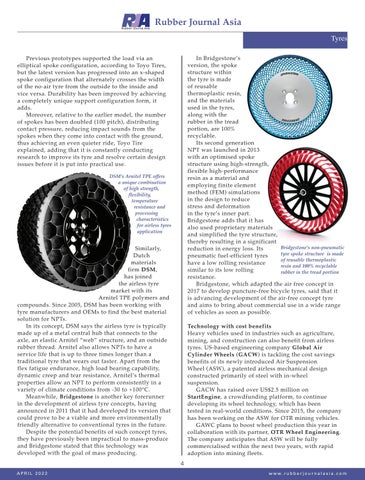Rubber Journal Asia Tyres In Bridgestone’s version, the spoke structure within the tyre is made of reusable thermoplastic resin, and the materials used in the tyres, along with the rubber in the tread portion, are 100% recyclable. Its second generation NPT was launched in 2013 with an optimised spoke structure using high-strength, flexible high-performance resin as a material and employing finite element method (FEM) simulations in the design to reduce stress and deformation in the tyre’s inner part. Bridgestone adds that it has also used proprietary materials and simplified the tyre structure, thereby resulting in a significant Bridgestone’s non-pneumatic reduction in energy loss. Its tyre spoke structure is made pneumatic fuel-efficient tyres of reusable thermoplastic have a low rolling resistance resin and 100% recyclable similar to its low rolling rubber in the tread portion resistance. Bridgestone, which adapted the air free concept in 2017 to develop puncture-free bicycle tyres, said that it is advancing development of the air-free concept tyre and aims to bring about commercial use in a wide range of vehicles as soon as possible.
Previous prototypes supported the load via an elliptical spoke configuration, according to Toyo Tires, but the latest version has progressed into an x-shaped spoke configuration that alternately crosses the width of the no-air tyre from the outside to the inside and vice versa. Durability has been improved by achieving a completely unique support configuration form, it adds. Moreover, relative to the earlier model, the number of spokes has been doubled (100 pitch), distributing contact pressure, reducing impact sounds from the spokes when they come into contact with the ground, thus achieving an even quieter ride, Toyo Tire explained, adding that it is constantly conducting research to improve its tyre and resolve certain design issues before it is put into practical use. DSM’s Arnitel TPE offers a unique combination of high strength, flexibility, temperature resistance and processing characteristics for airless tyres application
Similarly, Dutch materials firm DSM, has joined the airless tyre market with its Arnitel TPE polymers and compounds. Since 2005, DSM has been working with tyre manufacturers and OEMs to find the best material solution for NPTs. In its concept, DSM says the airless tyre is typically made up of a metal central hub that connects to the axle, an elastic Arnitel “web” structure, and an outside rubber thread. Arnitel also allows NPTs to have a service life that is up to three times longer than a traditional tyre that wears out faster. Apart from the flex fatigue endurance, high load bearing capability, dynamic creep and tear resistance, Arnitel’s thermal properties allow an NPT to perform consistently in a variety of climate conditions from -30 to +100°C. Meanwhile, Bridgestone is another key forerunner in the development of airless tyre concepts, having announced in 2011 that it had developed its version that could prove to be a viable and more environmentally friendly alternative to conventional tyres in the future. Despite the potential benefits of such concept tyres, they have previously been impractical to mass-produce and Bridgestone stated that this technology was developed with the goal of mass producing.
Technology with cost benefits Heavy vehicles used in industries such as agriculture, mining, and construction can also benefit from airless tyres. US-based engineering company Global Air Cylinder Wheels (GACW) is tackling the cost savings benefits of its newly introduced Air Suspension Wheel (ASW), a patented airless mechanical design constructed primarily of steel with in-wheel suspension. GACW has raised over US$2.5 million on StartEngine, a crowdfunding platform, to continue developing its wheel technology, which has been tested in real-world conditions. Since 2015, the company has been working on the ASW for OTR mining vehicles. GAWC plans to boost wheel production this year in collaboration with its partner, OTR Wheel Engineering. The company anticipates that ASW will be fully commercialised within the next two years, with rapid adoption into mining fleets.
4 APRIL 2022
www.rubberjournalasia.com
